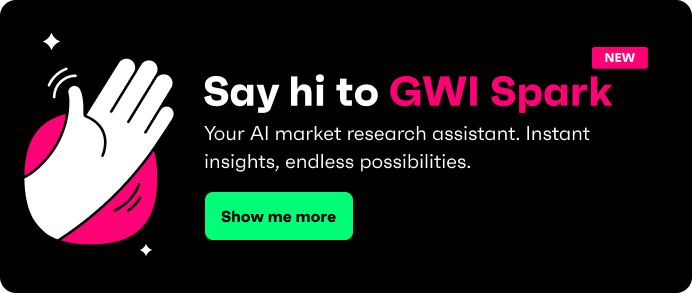
Trends move fast. Attention spans move faster. If you want to keep up with consumers, you need more than just data - you need to know what really makes them tick.
AI tools bring speed, scale, and efficiency to research. But real insight? That still comes from people. The smartest marketers are combining the power of AI with human thinking to unlock deeper, sharper consumer understanding.
What are consumer insights?
Consumer insights are the deeper understanding of why people behave the way they do, showing what drives decisions, shapes preferences, and defines values. Essentially, insights turn raw numbers into actions that actually matter.
Data tells you what happened. Insights tell you why it matters, meaning they’re super useful across every team. In marketing, they sharpen messaging. In product, they guide features. In strategy, they validate direction. Even with AI in the mix, consumer insights are still rooted in empathy, understanding, and context. It’s about going beyond the data and into the meaning, especially when audiences are shifting fast. For instance, understanding Gen Z characteristics in 2025 reveals a group that’s financially savvy, tech-forward, and redefining traditional life milestones.
That kind of depth is what separates real insight from generic assumptions.
Why knowing how to find consumer insights helps teams make better decisions
Teams that can uncover relevant insights quickly are more responsive and more confident in what they do, with less risk and without needing to rely on guesswork.
Instead of building campaigns based on assumptions or chasing competitors, you’re able to respond to real behaviors and needs. And because no generation behaves the same way, that insight has to be grounded in audience-specific data.
Take millennials. Many are balancing the 9-5 with passion projects, all while trying to stay on top of wellness trends and managing their financial goals. You might see a stressed project manager teaching yoga on weekends, whilst saving up to buy their first home. Ambitious but burnt out, tech-savvy but skeptical of in-your-face ads, they have a magic blend of ambition and pragmatism that makes them a uniquely complex audience to reach for brands.
Knowing these millennial characteristics helps shape more relevant content, product experiences, and messaging that hits the mark.
From traditional research to AI-accelerated insight
Traditional research has its strengths, of course. Focus groups, in-depth interviews, large-scale surveys all offer valuable context, but they aren’t built for today’s pace. You need answers faster. You need flexibility across markets and categories.
AI-powered tools meet that need, letting you tap into rich consumer data instantly and explore insights on the go. Still, fast answers only matter if you can trust where they actually came from. Data quality still matters. A tool like GWI Spark isn’t just fast, it’s built on reliable, global survey data. You and your teams can move quickly while maintaining confidence in what you find.
How to actually find consumer insights: Step-by-step guide
The clearer your goal, the better your insight. Here’s a process any team can use to uncover what matters, powered by both research logic and AI tools.
1. Start with a clear objective or question
Every insight hunt starts with a good question. Not just “what’s trending?”, but something more focused, like “why didn’t Gen Z click with our last campaign?” or “what do new parents really want in a baby monitor?” When your question is focused, your insights will be too. Clarity now saves confusion later.
2. Identify reliable data sources (e.g. survey-based, representative)
Not all data is created equal. The best, most useful insights come from sources that are consistent, verified, and transparent about how they gather information. Relying on platforms like GWI, who survey real consumers across global markets, means your decisions rest on solid ground.
3. Segment the audience meaningfully
Forget blanket demographics. Just because two people are the same age doesn’t mean they think or shop the same way. One 30 year old might be into vegan cooking, while another is obsessed with Formula 1 and gaming. Break your audience down by what they value, how they behave, or where they spend their time. So, you’re not just targeting “women aged 25–34.” You’re targeting wellness-focused urbanites who stream niche podcasts and care about ingredient sourcing. Precision wins.
4. Analyze for behavioral patterns and contextual relevance
Data is the starting point, but context helps connect all the dots. Look for what’s changing, what stands out, and what those shifts say about your audience's needs right now. Trends are useful, but only when tied to real-world meaning.
5. Visualize or summarize for communication
If it takes a 10-slide deck to explain, it’s probably not going to stick. The best insights are the ones your team repeats in meetings, drops into pitches, or uses to kickstart a brainstorm - simple, visual, and memorable. A chart showing “+20% growth in digital wallet usage” might look nice, but a simple headline like “Consumers are trusting their phones more than their banks” hits home faster and sparks conversation. If it can’t be explained clearly, it won’t be actioned effectively.
6. Sense-check or complement with human interpretation
Even the best models need a gut check. Share your findings with people who know the audience, brand, or market well, and ask them to look for alignment, challenge assumptions, and try and spot anything the data might miss. This is where raw information turns into informed intuition - quite the tongue-twister, but one remembering.
How to use GWI Spark to find high-quality consumer insights
GWI Spark is built for the pace of business today. It’s an AI assistant trained on real survey data from global consumers, giving you accurate, ready-to-use insights super-fast.
Instead of scraping online content or relying on unclear sources, GWI Spark pulls from GWI’s global research. Every data point is rooted in truth. Simply ask questions in plain language then explore audience traits or dig into local and global trends. You do this all on an intuitive interface, and get outputs designed to send straight to stakeholders.
Whether you're building campaigns or evaluating shopper behavior, the value lies in real-time, actionable insights. For example, if you're trying to understand credit card trends, GWI Spark can surface key behaviors like increased digital wallet adoption or the growing popularity of loyalty programs. Less digging, more doing.
The human role in an AI-powered process
AI makes research faster, sure. But people still bring the purpose. It’s like booting up your maps app - AI tells you the fastest route, but only you know if you need to stop for coffee, avoid traffic, or take the scenic route to snap some pics. The same goes for insights. Tools can get you there quicker, but only people know what matters most once they arrive.
People shape the strategy. Strategy, creativity, and brand instinct still belong to people. This is where your team brings the real magic. GWI Spark exists to support that thinking and strengthen it - and with the right balance, your teams can go further with less effort and stay focused on what really counts.
Common mistakes to avoid when looking for consumer insights
Even with the best tools, you can slip up. Here are some pitfalls worth avoiding:
- Assuming all sources are equal. Focus on representative, verified data.
- Overusing web or social data. These are surface-level signals. Always dig deeper.
- Skipping segmentation. Averages hide nuance. Slice your audience properly.
- Staying in silos. Share insights with other teams for better validation and use.
- Relying on patterns without meaning. A trend is only useful if you know why it matters.
Final thoughts: Blending precision with perspective
AI has changed how we access consumer insights. But the value still comes from what we do with them. The most effective strategies aren’t driven by data alone. They come from the blend of fast, trustworthy tools and smart, human thinking.
GWI Spark puts fast, accessible insights at your fingertips. It helps your teams stay sharp, curious, and confident, and the real impact comes when you bring your brand’s voice, goals, and creativity into the mix.
So, yes, let AI do the heavy lifting. But let people ask the big questions.





.webp?width=495&height=317&name=pink_thumb_graphs%20(1).webp)
.webp?width=495&height=317&name=pink_thumb_letter%20(2).webp)